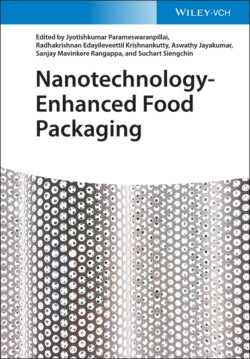Читать книгу Nanotechnology-Enhanced Food Packaging - Группа авторов - Страница 16
1.4 Nanotechnology in Food Packaging
ОглавлениеIn food packaging, monolayer films cannot satisfy all the requirement because different food commodities require different barrier and mechanical properties. Polymer nanocomposites are the latest materials aimed at solving this problem. Polymer nanocomposites are prepared by dispersing an inert, nanoscale filler in a polymeric matrix. The widely used filler materials are silica (SiO2), clay, cellulose-based nanofibers, graphene, silicate nanoplatelets, starch nanocrystals, carbon nanotubes, chitin or chitosan nanoparticles, etc. The nanocomposite can enhance barrier properties, flame resistance, better thermal properties, and alterations in surface wettability and hydrophobicity. European Food Safety Authority approved that the nano-TiN to use in package material can contact with food material. It is widely used in processing aid and to improve mechanical strength of polyester (PET).
Intelligent and successful food nano-based packaging offers many advantages, including improved mechanical strength packaging products, barrier properties, antimicrobial film for nano-sensing (Figure 1.1) pathogen identification, and food safety warning over traditional packaging techniques. Nanocomposites can also be used as active ingredients in packaging and coating material to improve food packaging. Several researchers were involved in investigating the antimicrobial effects of organic compounds in polymeric matrices, such as organic acids, essential oils, and nisin. However, these compounds do not comply with the many processing stages that require high temperatures and pressures because they are highly sensitive to these physical conditions. The use of inorganic nanoparticles allows for good antibacterial activity at low concentrations and increased stability under intense conditions [27]. The use of these nanoparticles in antimicrobial food packaging was therefore very important in recent years.
Nanocor® supplies specially designed plastic nanocomposites (nanoclays) owned by AMCOL International. Durethan® is used in food packaging and medical fields. It provides excellent gas and moisture barrier properties, strength, toughness, and chemical resistance. In South Korea, Hite Pitcher beer bottles were made out of Aegis™ OXCE (nylon 6 nanoclay composite) developed by Honeywell Polymer. It has high-oxygen barrier properties designed for alcoholic beverage and beer. A milk bottle and baby mug incorporated with silver nanoparticles have been developed by Baby Dream Co., Ltd., an infant product company in South Korea.
Figure 1.1 Features of food nano-packaging applied in the food industry [2].
Antimicrobial packaging is not limited to antimicrobial products, but nano-compositions and nanolaminates are widely used in product packaging to resist intense mechanical and thermal shocks, which increase food shelf life. The incorporation of nanoparticles into packaging materials provides quality foods with longer durability. Moreover, to ensure the highest food-grading quality and standard, polymer composites are designed to supply both thermostable and usable packaging materials. Numerous inorganic or organic fillers are used to produce better polymer composites. The addition of nanoparticles in polymers has made it possible to develop robust, cost-effective packaging material.
